IFRS Financial Reporting: An Analysis of Alacer Gold Corp's Items
VerifiedAdded on 2023/06/05
|7
|1787
|333
Report
AI Summary
This report provides an analysis of Alacer Gold Corp's financial reporting, focusing on key items such as property, plant, and equipment, leases, revenues, intangible assets, and provisions, all under the framework of International Financial Reporting Standards (IFRS). The analysis highlights the company's valuation methods, particularly the use of historical cost for non-current assets and the recognition of provisions based on present obligations. The report also discusses the absence of intangible assets and leases in the company's financial statements and concludes that Alacer Gold Corp's financial reports are prepared in accordance with IFRS issued by the International Accounting Standards Board (IASB). Desklib provides students with access to a variety of solved assignments and past papers to aid in their studies.
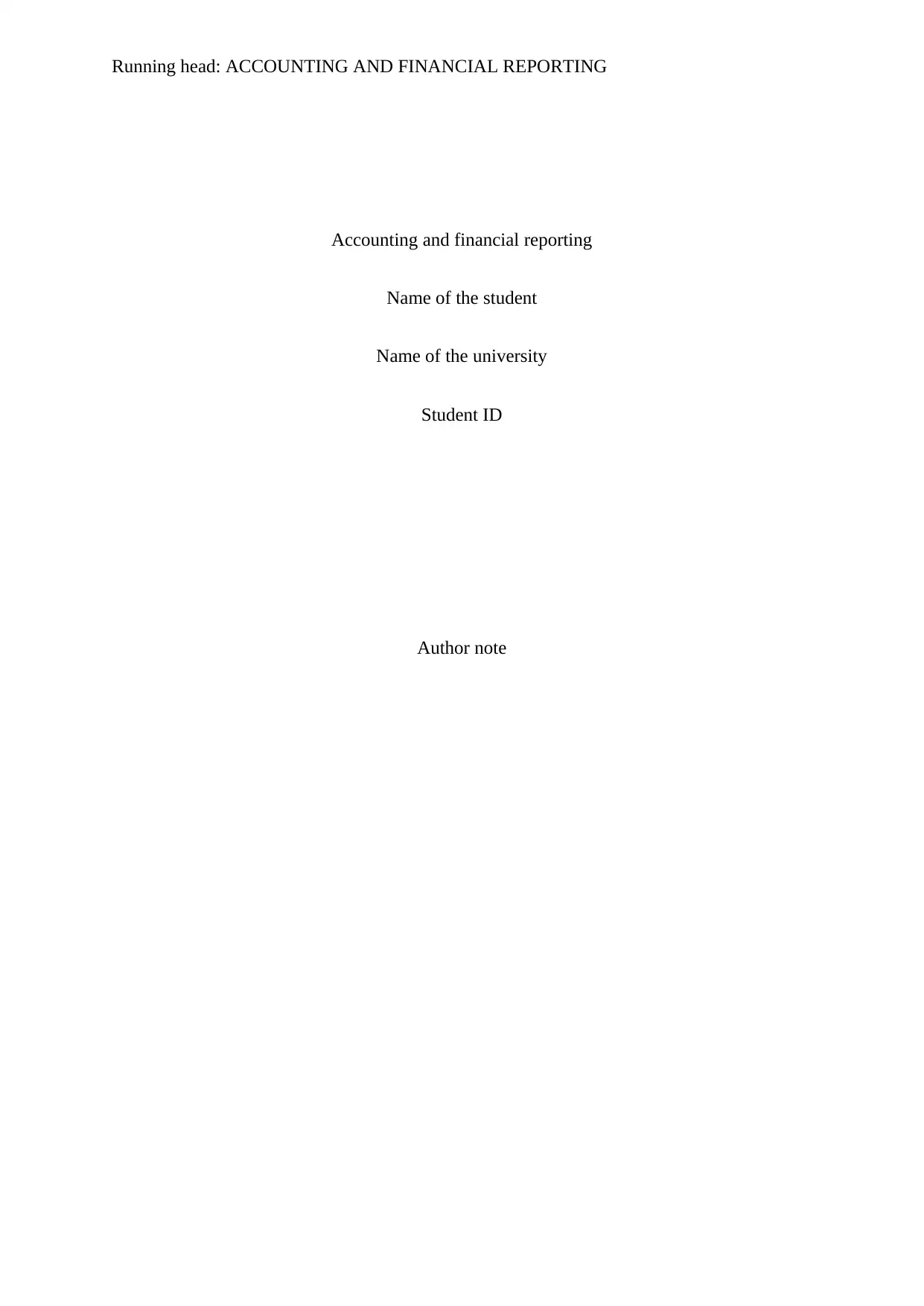
Running head: ACCOUNTING AND FINANCIAL REPORTING
Accounting and financial reporting
Name of the student
Name of the university
Student ID
Author note
Accounting and financial reporting
Name of the student
Name of the university
Student ID
Author note
Paraphrase This Document
Need a fresh take? Get an instant paraphrase of this document with our AI Paraphraser
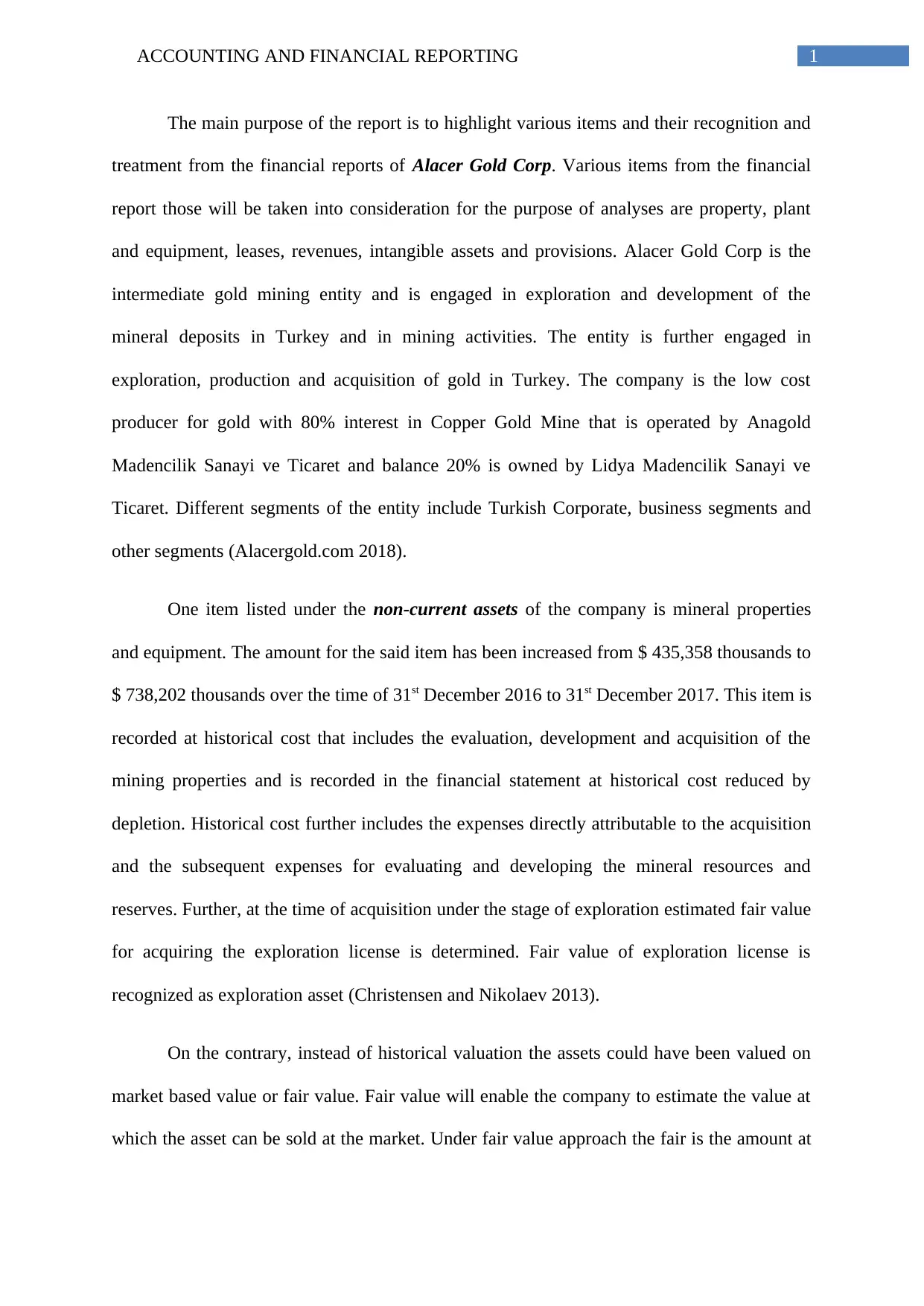
1ACCOUNTING AND FINANCIAL REPORTING
The main purpose of the report is to highlight various items and their recognition and
treatment from the financial reports of Alacer Gold Corp. Various items from the financial
report those will be taken into consideration for the purpose of analyses are property, plant
and equipment, leases, revenues, intangible assets and provisions. Alacer Gold Corp is the
intermediate gold mining entity and is engaged in exploration and development of the
mineral deposits in Turkey and in mining activities. The entity is further engaged in
exploration, production and acquisition of gold in Turkey. The company is the low cost
producer for gold with 80% interest in Copper Gold Mine that is operated by Anagold
Madencilik Sanayi ve Ticaret and balance 20% is owned by Lidya Madencilik Sanayi ve
Ticaret. Different segments of the entity include Turkish Corporate, business segments and
other segments (Alacergold.com 2018).
One item listed under the non-current assets of the company is mineral properties
and equipment. The amount for the said item has been increased from $ 435,358 thousands to
$ 738,202 thousands over the time of 31st December 2016 to 31st December 2017. This item is
recorded at historical cost that includes the evaluation, development and acquisition of the
mining properties and is recorded in the financial statement at historical cost reduced by
depletion. Historical cost further includes the expenses directly attributable to the acquisition
and the subsequent expenses for evaluating and developing the mineral resources and
reserves. Further, at the time of acquisition under the stage of exploration estimated fair value
for acquiring the exploration license is determined. Fair value of exploration license is
recognized as exploration asset (Christensen and Nikolaev 2013).
On the contrary, instead of historical valuation the assets could have been valued on
market based value or fair value. Fair value will enable the company to estimate the value at
which the asset can be sold at the market. Under fair value approach the fair is the amount at
The main purpose of the report is to highlight various items and their recognition and
treatment from the financial reports of Alacer Gold Corp. Various items from the financial
report those will be taken into consideration for the purpose of analyses are property, plant
and equipment, leases, revenues, intangible assets and provisions. Alacer Gold Corp is the
intermediate gold mining entity and is engaged in exploration and development of the
mineral deposits in Turkey and in mining activities. The entity is further engaged in
exploration, production and acquisition of gold in Turkey. The company is the low cost
producer for gold with 80% interest in Copper Gold Mine that is operated by Anagold
Madencilik Sanayi ve Ticaret and balance 20% is owned by Lidya Madencilik Sanayi ve
Ticaret. Different segments of the entity include Turkish Corporate, business segments and
other segments (Alacergold.com 2018).
One item listed under the non-current assets of the company is mineral properties
and equipment. The amount for the said item has been increased from $ 435,358 thousands to
$ 738,202 thousands over the time of 31st December 2016 to 31st December 2017. This item is
recorded at historical cost that includes the evaluation, development and acquisition of the
mining properties and is recorded in the financial statement at historical cost reduced by
depletion. Historical cost further includes the expenses directly attributable to the acquisition
and the subsequent expenses for evaluating and developing the mineral resources and
reserves. Further, at the time of acquisition under the stage of exploration estimated fair value
for acquiring the exploration license is determined. Fair value of exploration license is
recognized as exploration asset (Christensen and Nikolaev 2013).
On the contrary, instead of historical valuation the assets could have been valued on
market based value or fair value. Fair value will enable the company to estimate the value at
which the asset can be sold at the market. Under fair value approach the fair is the amount at
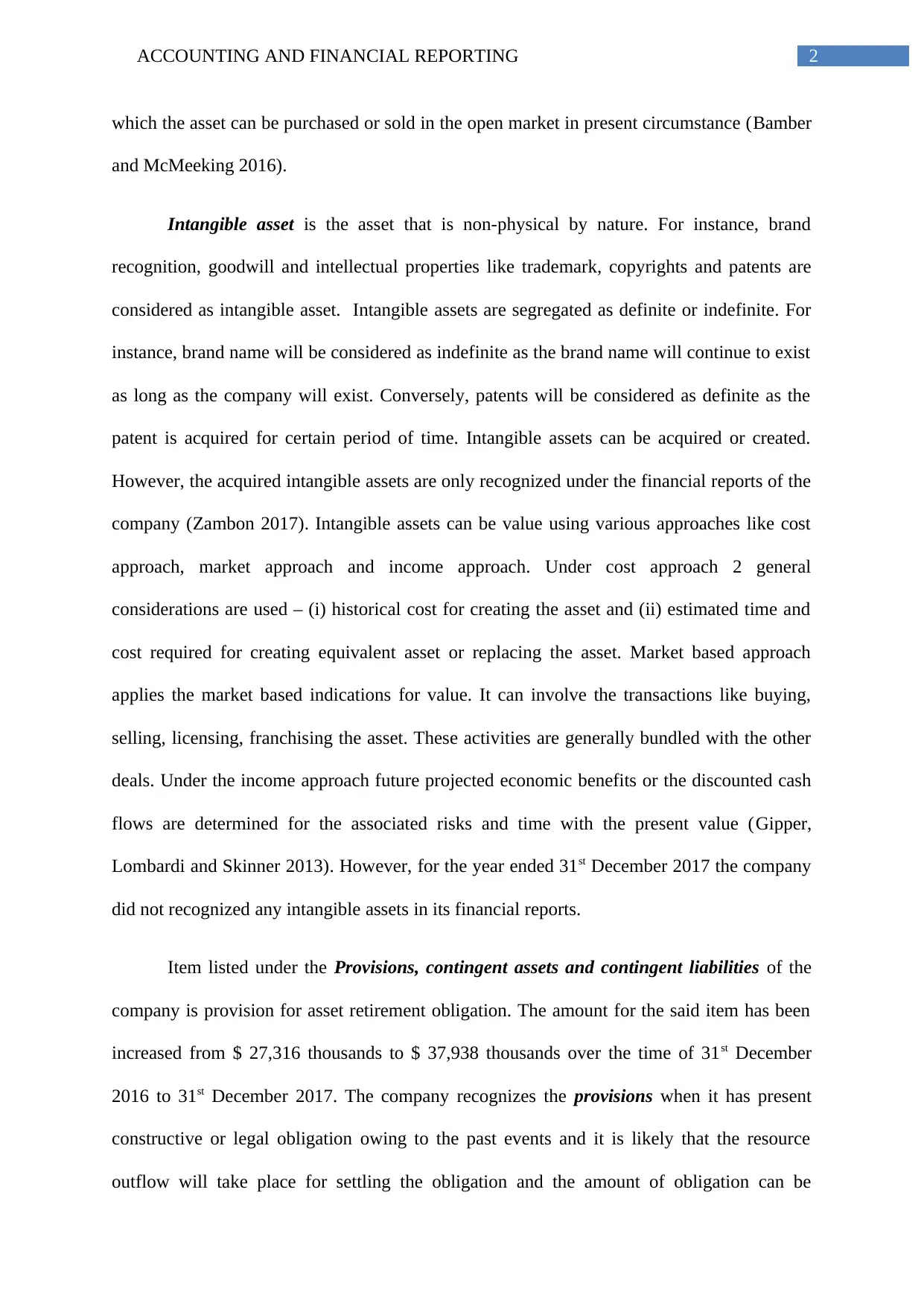
2ACCOUNTING AND FINANCIAL REPORTING
which the asset can be purchased or sold in the open market in present circumstance (Bamber
and McMeeking 2016).
Intangible asset is the asset that is non-physical by nature. For instance, brand
recognition, goodwill and intellectual properties like trademark, copyrights and patents are
considered as intangible asset. Intangible assets are segregated as definite or indefinite. For
instance, brand name will be considered as indefinite as the brand name will continue to exist
as long as the company will exist. Conversely, patents will be considered as definite as the
patent is acquired for certain period of time. Intangible assets can be acquired or created.
However, the acquired intangible assets are only recognized under the financial reports of the
company (Zambon 2017). Intangible assets can be value using various approaches like cost
approach, market approach and income approach. Under cost approach 2 general
considerations are used – (i) historical cost for creating the asset and (ii) estimated time and
cost required for creating equivalent asset or replacing the asset. Market based approach
applies the market based indications for value. It can involve the transactions like buying,
selling, licensing, franchising the asset. These activities are generally bundled with the other
deals. Under the income approach future projected economic benefits or the discounted cash
flows are determined for the associated risks and time with the present value (Gipper,
Lombardi and Skinner 2013). However, for the year ended 31st December 2017 the company
did not recognized any intangible assets in its financial reports.
Item listed under the Provisions, contingent assets and contingent liabilities of the
company is provision for asset retirement obligation. The amount for the said item has been
increased from $ 27,316 thousands to $ 37,938 thousands over the time of 31st December
2016 to 31st December 2017. The company recognizes the provisions when it has present
constructive or legal obligation owing to the past events and it is likely that the resource
outflow will take place for settling the obligation and the amount of obligation can be
which the asset can be purchased or sold in the open market in present circumstance (Bamber
and McMeeking 2016).
Intangible asset is the asset that is non-physical by nature. For instance, brand
recognition, goodwill and intellectual properties like trademark, copyrights and patents are
considered as intangible asset. Intangible assets are segregated as definite or indefinite. For
instance, brand name will be considered as indefinite as the brand name will continue to exist
as long as the company will exist. Conversely, patents will be considered as definite as the
patent is acquired for certain period of time. Intangible assets can be acquired or created.
However, the acquired intangible assets are only recognized under the financial reports of the
company (Zambon 2017). Intangible assets can be value using various approaches like cost
approach, market approach and income approach. Under cost approach 2 general
considerations are used – (i) historical cost for creating the asset and (ii) estimated time and
cost required for creating equivalent asset or replacing the asset. Market based approach
applies the market based indications for value. It can involve the transactions like buying,
selling, licensing, franchising the asset. These activities are generally bundled with the other
deals. Under the income approach future projected economic benefits or the discounted cash
flows are determined for the associated risks and time with the present value (Gipper,
Lombardi and Skinner 2013). However, for the year ended 31st December 2017 the company
did not recognized any intangible assets in its financial reports.
Item listed under the Provisions, contingent assets and contingent liabilities of the
company is provision for asset retirement obligation. The amount for the said item has been
increased from $ 27,316 thousands to $ 37,938 thousands over the time of 31st December
2016 to 31st December 2017. The company recognizes the provisions when it has present
constructive or legal obligation owing to the past events and it is likely that the resource
outflow will take place for settling the obligation and the amount of obligation can be
⊘ This is a preview!⊘
Do you want full access?
Subscribe today to unlock all pages.

Trusted by 1+ million students worldwide
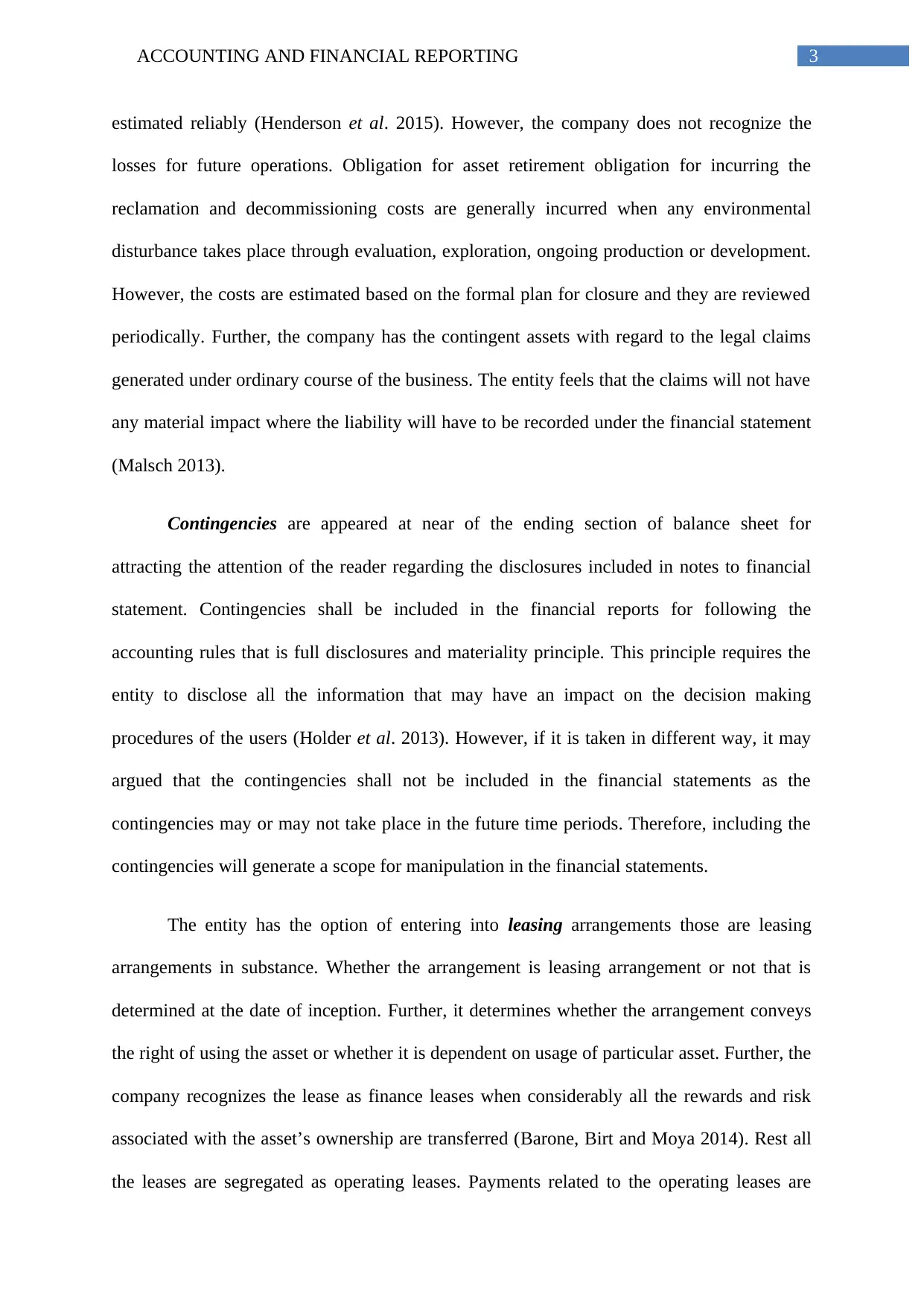
3ACCOUNTING AND FINANCIAL REPORTING
estimated reliably (Henderson et al. 2015). However, the company does not recognize the
losses for future operations. Obligation for asset retirement obligation for incurring the
reclamation and decommissioning costs are generally incurred when any environmental
disturbance takes place through evaluation, exploration, ongoing production or development.
However, the costs are estimated based on the formal plan for closure and they are reviewed
periodically. Further, the company has the contingent assets with regard to the legal claims
generated under ordinary course of the business. The entity feels that the claims will not have
any material impact where the liability will have to be recorded under the financial statement
(Malsch 2013).
Contingencies are appeared at near of the ending section of balance sheet for
attracting the attention of the reader regarding the disclosures included in notes to financial
statement. Contingencies shall be included in the financial reports for following the
accounting rules that is full disclosures and materiality principle. This principle requires the
entity to disclose all the information that may have an impact on the decision making
procedures of the users (Holder et al. 2013). However, if it is taken in different way, it may
argued that the contingencies shall not be included in the financial statements as the
contingencies may or may not take place in the future time periods. Therefore, including the
contingencies will generate a scope for manipulation in the financial statements.
The entity has the option of entering into leasing arrangements those are leasing
arrangements in substance. Whether the arrangement is leasing arrangement or not that is
determined at the date of inception. Further, it determines whether the arrangement conveys
the right of using the asset or whether it is dependent on usage of particular asset. Further, the
company recognizes the lease as finance leases when considerably all the rewards and risk
associated with the asset’s ownership are transferred (Barone, Birt and Moya 2014). Rest all
the leases are segregated as operating leases. Payments related to the operating leases are
estimated reliably (Henderson et al. 2015). However, the company does not recognize the
losses for future operations. Obligation for asset retirement obligation for incurring the
reclamation and decommissioning costs are generally incurred when any environmental
disturbance takes place through evaluation, exploration, ongoing production or development.
However, the costs are estimated based on the formal plan for closure and they are reviewed
periodically. Further, the company has the contingent assets with regard to the legal claims
generated under ordinary course of the business. The entity feels that the claims will not have
any material impact where the liability will have to be recorded under the financial statement
(Malsch 2013).
Contingencies are appeared at near of the ending section of balance sheet for
attracting the attention of the reader regarding the disclosures included in notes to financial
statement. Contingencies shall be included in the financial reports for following the
accounting rules that is full disclosures and materiality principle. This principle requires the
entity to disclose all the information that may have an impact on the decision making
procedures of the users (Holder et al. 2013). However, if it is taken in different way, it may
argued that the contingencies shall not be included in the financial statements as the
contingencies may or may not take place in the future time periods. Therefore, including the
contingencies will generate a scope for manipulation in the financial statements.
The entity has the option of entering into leasing arrangements those are leasing
arrangements in substance. Whether the arrangement is leasing arrangement or not that is
determined at the date of inception. Further, it determines whether the arrangement conveys
the right of using the asset or whether it is dependent on usage of particular asset. Further, the
company recognizes the lease as finance leases when considerably all the rewards and risk
associated with the asset’s ownership are transferred (Barone, Birt and Moya 2014). Rest all
the leases are segregated as operating leases. Payments related to the operating leases are
Paraphrase This Document
Need a fresh take? Get an instant paraphrase of this document with our AI Paraphraser
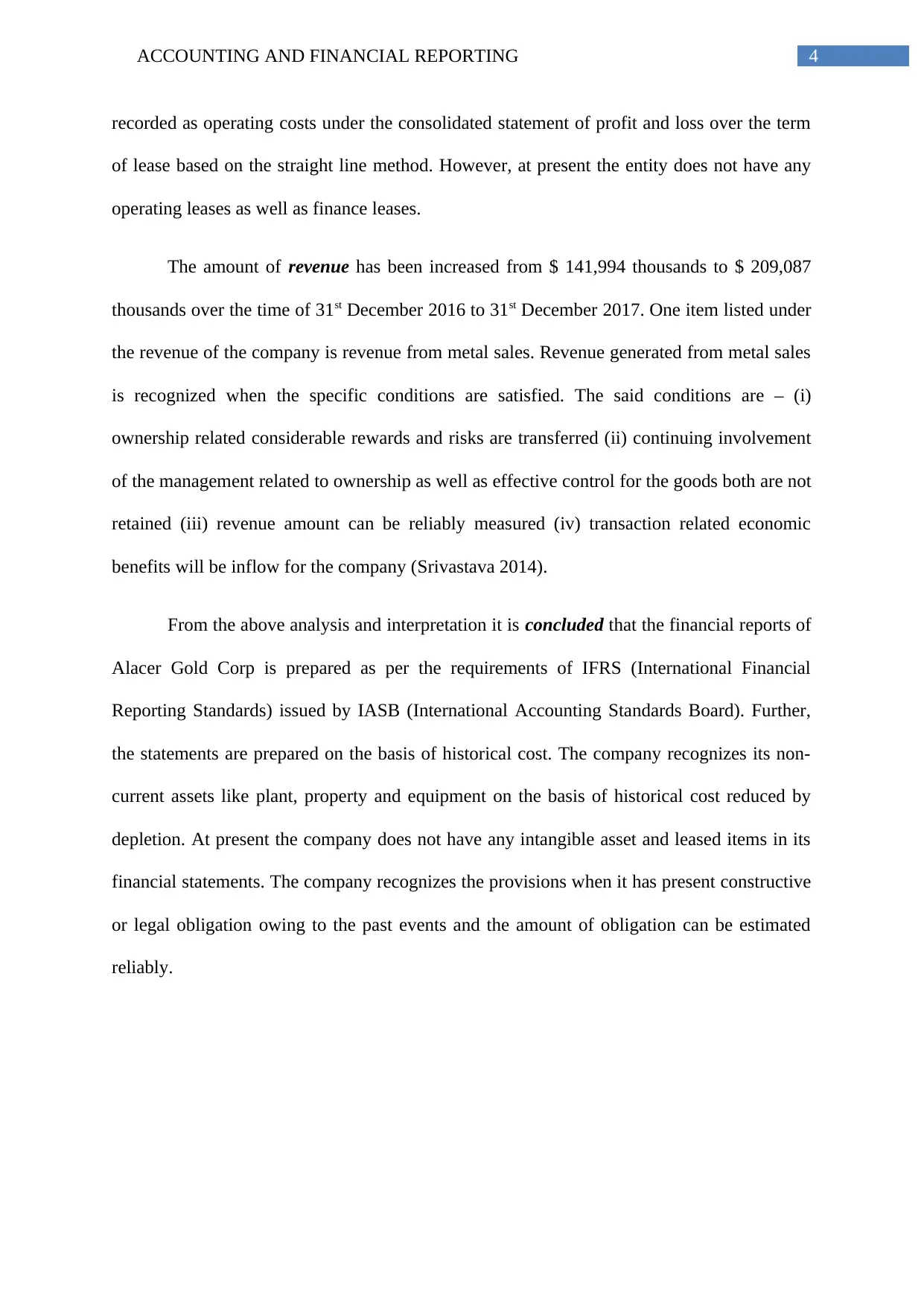
4ACCOUNTING AND FINANCIAL REPORTING
recorded as operating costs under the consolidated statement of profit and loss over the term
of lease based on the straight line method. However, at present the entity does not have any
operating leases as well as finance leases.
The amount of revenue has been increased from $ 141,994 thousands to $ 209,087
thousands over the time of 31st December 2016 to 31st December 2017. One item listed under
the revenue of the company is revenue from metal sales. Revenue generated from metal sales
is recognized when the specific conditions are satisfied. The said conditions are – (i)
ownership related considerable rewards and risks are transferred (ii) continuing involvement
of the management related to ownership as well as effective control for the goods both are not
retained (iii) revenue amount can be reliably measured (iv) transaction related economic
benefits will be inflow for the company (Srivastava 2014).
From the above analysis and interpretation it is concluded that the financial reports of
Alacer Gold Corp is prepared as per the requirements of IFRS (International Financial
Reporting Standards) issued by IASB (International Accounting Standards Board). Further,
the statements are prepared on the basis of historical cost. The company recognizes its non-
current assets like plant, property and equipment on the basis of historical cost reduced by
depletion. At present the company does not have any intangible asset and leased items in its
financial statements. The company recognizes the provisions when it has present constructive
or legal obligation owing to the past events and the amount of obligation can be estimated
reliably.
recorded as operating costs under the consolidated statement of profit and loss over the term
of lease based on the straight line method. However, at present the entity does not have any
operating leases as well as finance leases.
The amount of revenue has been increased from $ 141,994 thousands to $ 209,087
thousands over the time of 31st December 2016 to 31st December 2017. One item listed under
the revenue of the company is revenue from metal sales. Revenue generated from metal sales
is recognized when the specific conditions are satisfied. The said conditions are – (i)
ownership related considerable rewards and risks are transferred (ii) continuing involvement
of the management related to ownership as well as effective control for the goods both are not
retained (iii) revenue amount can be reliably measured (iv) transaction related economic
benefits will be inflow for the company (Srivastava 2014).
From the above analysis and interpretation it is concluded that the financial reports of
Alacer Gold Corp is prepared as per the requirements of IFRS (International Financial
Reporting Standards) issued by IASB (International Accounting Standards Board). Further,
the statements are prepared on the basis of historical cost. The company recognizes its non-
current assets like plant, property and equipment on the basis of historical cost reduced by
depletion. At present the company does not have any intangible asset and leased items in its
financial statements. The company recognizes the provisions when it has present constructive
or legal obligation owing to the past events and the amount of obligation can be estimated
reliably.
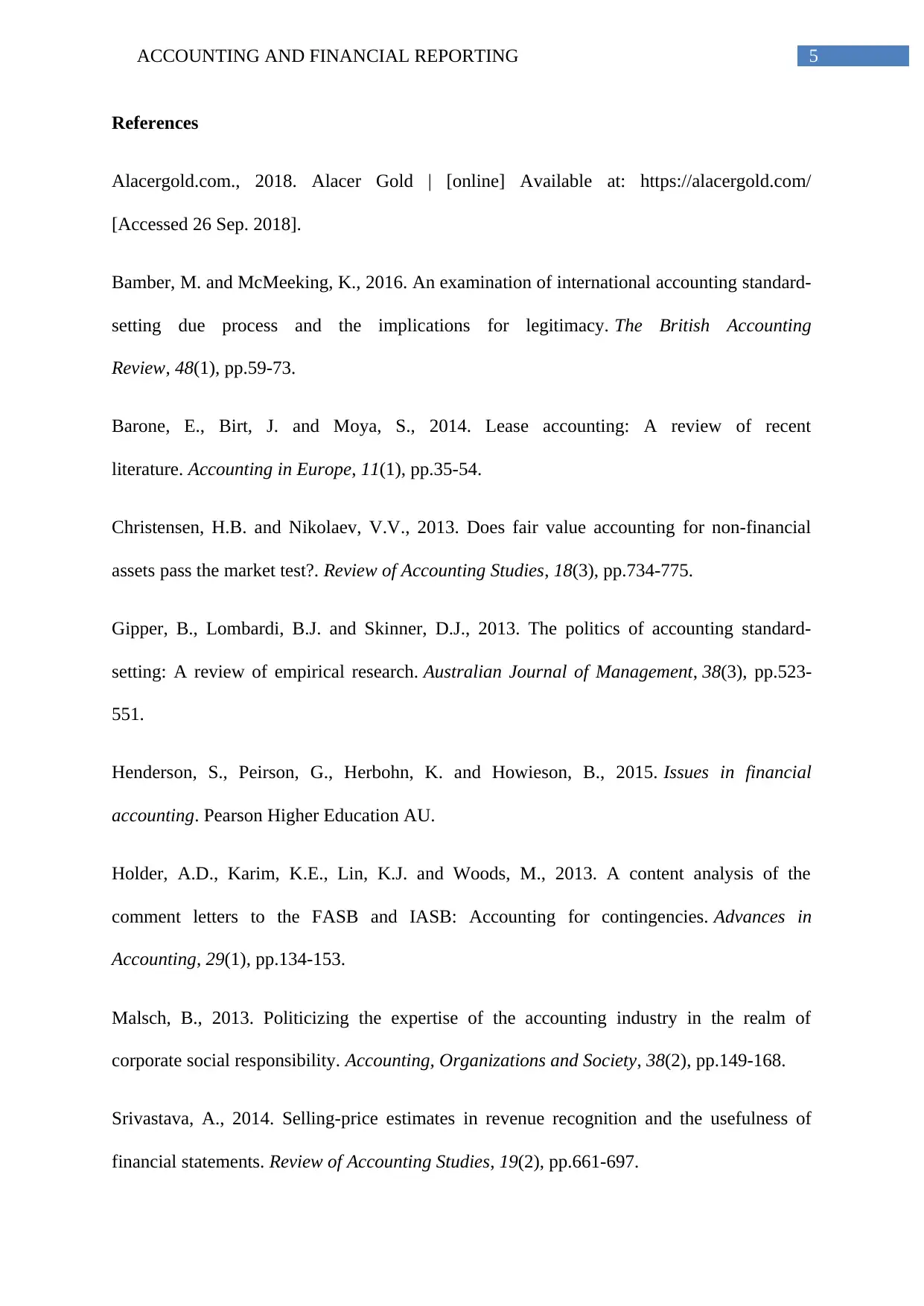
5ACCOUNTING AND FINANCIAL REPORTING
References
Alacergold.com., 2018. Alacer Gold | [online] Available at: https://alacergold.com/
[Accessed 26 Sep. 2018].
Bamber, M. and McMeeking, K., 2016. An examination of international accounting standard-
setting due process and the implications for legitimacy. The British Accounting
Review, 48(1), pp.59-73.
Barone, E., Birt, J. and Moya, S., 2014. Lease accounting: A review of recent
literature. Accounting in Europe, 11(1), pp.35-54.
Christensen, H.B. and Nikolaev, V.V., 2013. Does fair value accounting for non-financial
assets pass the market test?. Review of Accounting Studies, 18(3), pp.734-775.
Gipper, B., Lombardi, B.J. and Skinner, D.J., 2013. The politics of accounting standard-
setting: A review of empirical research. Australian Journal of Management, 38(3), pp.523-
551.
Henderson, S., Peirson, G., Herbohn, K. and Howieson, B., 2015. Issues in financial
accounting. Pearson Higher Education AU.
Holder, A.D., Karim, K.E., Lin, K.J. and Woods, M., 2013. A content analysis of the
comment letters to the FASB and IASB: Accounting for contingencies. Advances in
Accounting, 29(1), pp.134-153.
Malsch, B., 2013. Politicizing the expertise of the accounting industry in the realm of
corporate social responsibility. Accounting, Organizations and Society, 38(2), pp.149-168.
Srivastava, A., 2014. Selling-price estimates in revenue recognition and the usefulness of
financial statements. Review of Accounting Studies, 19(2), pp.661-697.
References
Alacergold.com., 2018. Alacer Gold | [online] Available at: https://alacergold.com/
[Accessed 26 Sep. 2018].
Bamber, M. and McMeeking, K., 2016. An examination of international accounting standard-
setting due process and the implications for legitimacy. The British Accounting
Review, 48(1), pp.59-73.
Barone, E., Birt, J. and Moya, S., 2014. Lease accounting: A review of recent
literature. Accounting in Europe, 11(1), pp.35-54.
Christensen, H.B. and Nikolaev, V.V., 2013. Does fair value accounting for non-financial
assets pass the market test?. Review of Accounting Studies, 18(3), pp.734-775.
Gipper, B., Lombardi, B.J. and Skinner, D.J., 2013. The politics of accounting standard-
setting: A review of empirical research. Australian Journal of Management, 38(3), pp.523-
551.
Henderson, S., Peirson, G., Herbohn, K. and Howieson, B., 2015. Issues in financial
accounting. Pearson Higher Education AU.
Holder, A.D., Karim, K.E., Lin, K.J. and Woods, M., 2013. A content analysis of the
comment letters to the FASB and IASB: Accounting for contingencies. Advances in
Accounting, 29(1), pp.134-153.
Malsch, B., 2013. Politicizing the expertise of the accounting industry in the realm of
corporate social responsibility. Accounting, Organizations and Society, 38(2), pp.149-168.
Srivastava, A., 2014. Selling-price estimates in revenue recognition and the usefulness of
financial statements. Review of Accounting Studies, 19(2), pp.661-697.
⊘ This is a preview!⊘
Do you want full access?
Subscribe today to unlock all pages.

Trusted by 1+ million students worldwide
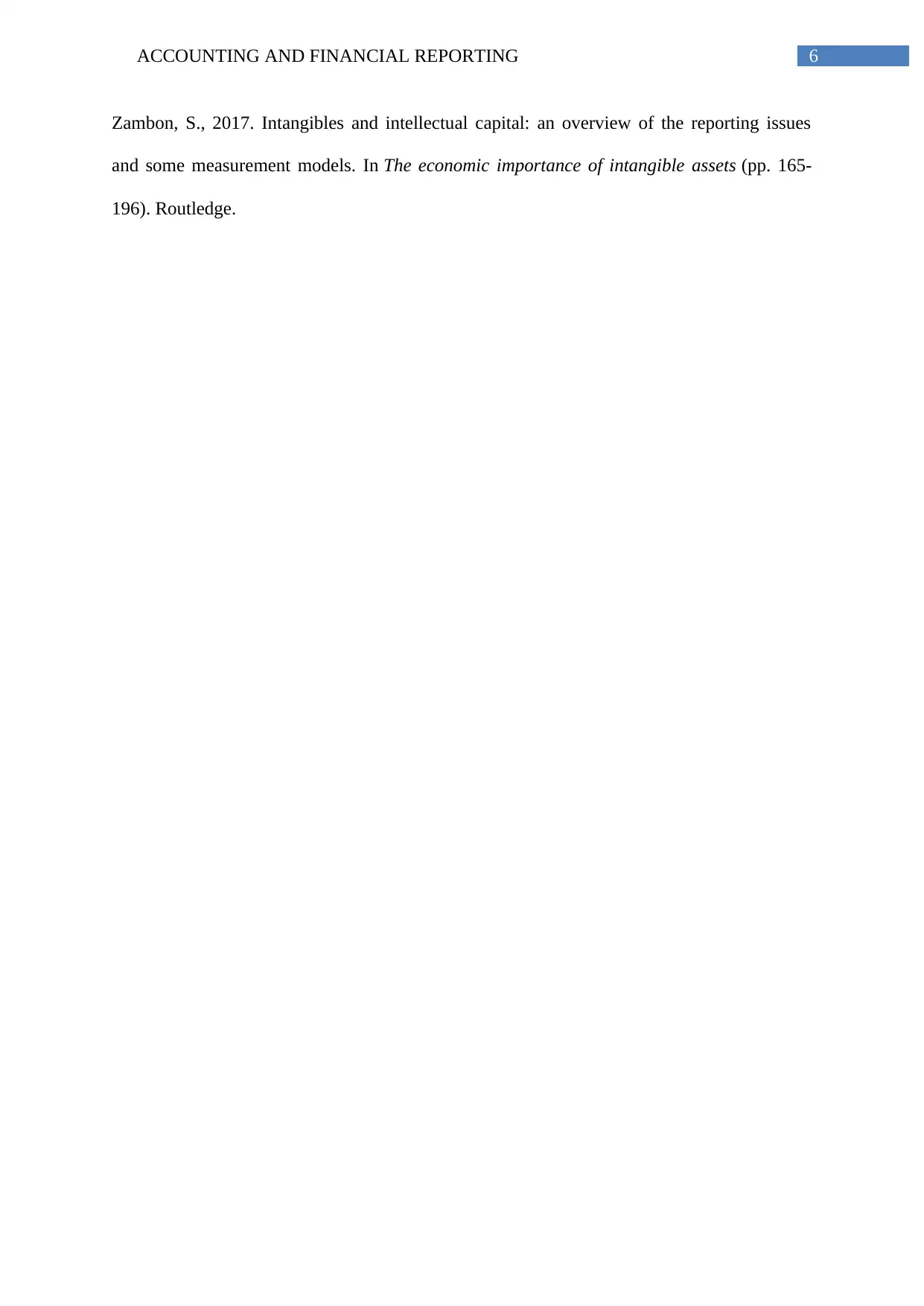
6ACCOUNTING AND FINANCIAL REPORTING
Zambon, S., 2017. Intangibles and intellectual capital: an overview of the reporting issues
and some measurement models. In The economic importance of intangible assets (pp. 165-
196). Routledge.
Zambon, S., 2017. Intangibles and intellectual capital: an overview of the reporting issues
and some measurement models. In The economic importance of intangible assets (pp. 165-
196). Routledge.
1 out of 7
Related Documents
Your All-in-One AI-Powered Toolkit for Academic Success.
+13062052269
info@desklib.com
Available 24*7 on WhatsApp / Email
![[object Object]](/_next/static/media/star-bottom.7253800d.svg)
Unlock your academic potential
Copyright © 2020–2025 A2Z Services. All Rights Reserved. Developed and managed by ZUCOL.





